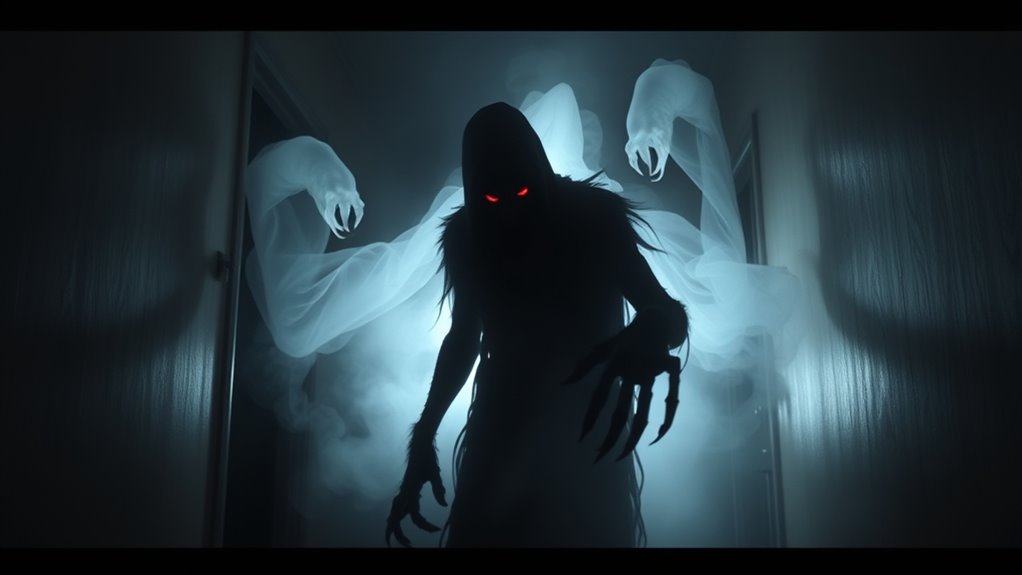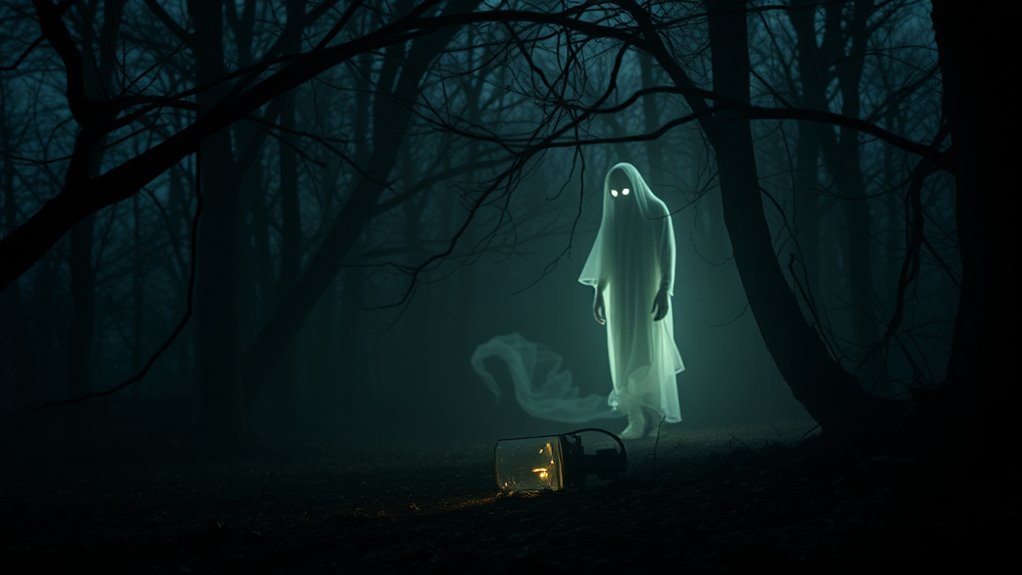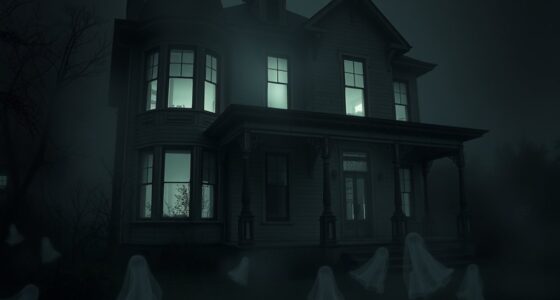To tell if you’re dealing with a ghost or a demon, observe their behavior and impact. Ghosts are often tied to specific locations or memories, may seek closure, and usually don’t cause physical harm. Demons, however, tend to be more malevolent, attach to individuals, and aim to instill fear or cause harm. Trust your instincts and stay cautious—learning more will help you identify which presence you’re facing and how to handle it.
Key Takeaways
- Ghosts usually stay near specific locations or memories, while demons often target individuals directly.
- Poltergeist activity involves loud noises and object movement, whereas demons tend to exhibit malevolent, harmful behaviors.
- Ghosts typically seek closure or communicate, while demons aim to instill fear and exert control.
- Persistent, escalating negative energy or harm indicates demonic presence; poltergeist activity often diminishes with emotional resolution.
- Recognizing signs of malevolence, physical or psychological harm, helps differentiate a demon from a benign ghost.

Have you ever wondered whether that chilling presence you felt was a ghost or a demon? Sometimes, the signs can be subtle, but understanding the differences can help you figure out what’s haunting you. One key aspect to contemplate is poltergeist activity, which often involves loud noises, objects moving on their own, and other disruptive phenomena. These disturbances are typically linked to restless spirits, often teenagers or individuals experiencing emotional turmoil. In contrast, demons tend to manifest through more intense, malevolent behaviors, aiming to instill fear and exert control. Recognizing whether your experiences involve poltergeist activity or something darker can guide you in how to respond.
Distinguishing ghosts from demons is vital; their behaviors and intentions differ significantly.
A major factor in distinguishing these entities is the idea of spiritual attachment. Ghosts, especially those of humans who haven’t moved on, often remain tied to specific locations or memories. They might be confused, seeking closure, or simply unaware they’ve died. Their presence may feel unsettling but usually doesn’t involve direct harm. Conversely, demons are believed to possess a more malicious intent, often attaching themselves to individuals rather than places. They thrive on fear, anger, and negative energy, and their presence can escalate into physical or psychological attacks. If you notice an entity that seems to drain your energy, manipulate your thoughts, or cause physical harm, it could indicate a demonic attachment rather than a benign spirit.
Another clue lies in how these entities behave over time. Poltergeist activity tends to spike during stressful periods or emotional upheaval, often linked to specific individuals or locations. Once the source of the disturbance is addressed or the emotional tension subsides, the activity usually diminishes. Demonic presences, however, tend to persist or even grow stronger despite efforts to banish them. They often target individuals with persistent negative patterns or vulnerabilities, feeding off their fear and suffering. Recognizing this pattern can help you determine whether you’re dealing with a temporary poltergeist or a more entrenched demonic force. Additionally, scientific skepticism suggests that many paranormal experiences can be explained through psychological or environmental factors, encouraging a balanced approach to such phenomena. Understanding these explanations can help you approach your situation with rationality and caution. Other methods such as psychological analysis can sometimes help clarify whether the experiences are rooted in mental health issues or external influences. Moreover, some methods such as spiritual cleansing may be necessary if the activity escalates or becomes more threatening.
Understanding the methods used by ethical hackers to identify vulnerabilities can help you better protect yourself against potential threats, whether in cybersecurity or other areas of safety. Ultimately, understanding the nature of what’s haunting you involves paying close attention to the behavior and impact of the entity. While poltergeist activity might be unsettling but manageable, a spiritual attachment to a demon can pose serious risks. If you’re unsure, it’s wise to consult a professional who specializes in paranormal phenomena or spiritual cleansing. Trust your instincts, stay cautious, and remember that identifying the true nature of your haunting is the first step toward reclaiming your space and peace of mind.
Frequently Asked Questions
Can Objects Move on Their Own During a Haunting?
Yes, objects can move on their own during a haunting, often indicating poltergeist activity. You might notice haunted artifacts shifting or falling without explanation, which is common in cases of restless spirits. These unexplained movements typically suggest a poltergeist rather than a demon. If you experience this, stay cautious and consider consulting a professional to assess whether the activity is benign or potentially harmful.
Are Certain Locations More Prone to Demonic Activity?
Certain locations are more prone to demonic activity, often labeled as haunted locations or demonic hotspots. You’ll notice these places tend to have a darker history, intense energy, or frequent negative occurrences. If you visit these sites, you might experience more aggressive or malevolent sensations. Stay alert, trust your instincts, and remember that these areas are more susceptible to demonic influences, making them riskier for paranormal encounters.
How Can I Protect Myself From Malevolent Spirits?
To protect yourself from malevolent spirits, you should perform regular spiritual cleansing to clear negative energies. Use protective amulets or talismans, such as symbols or stones believed to ward off evil. Keep your space spiritually secure by maintaining positive energy, and consider setting strong intentions or prayers to shield yourself. Staying grounded and aware helps you recognize and defend against harmful entities effectively.
Is It Possible to Communicate With Spirits Directly?
Imagine holding a fragile thread between worlds, yearning for spiritual communication. You can attempt paranormal dialogue through methods like Ouija boards, tarot, or meditation, but remember, spirits often choose to communicate on their own terms. While direct contact is possible, it’s unpredictable and risky. Approach with caution, respect, and an open mind—sometimes the most profound messages come silently, beyond our reach, reminding you that not all spirits wish to speak openly.
What Are Common Signs of Possession Versus a Ghost?
When you notice unusual paranormal activity, it’s important to distinguish between signs of possession and a ghost. Possession often involves a change in behavior, intense fear, or malevolent spiritual energy, while a ghost typically manifests as apparitions, cold spots, or unexplained noises. Trust your instincts and observe the nature of the spiritual energy around you. Recognizing these signs helps you understand if you’re dealing with a benign ghost or something more threatening.
Conclusion
Understanding whether you’re dealing with a ghost or demon can be intimidating, but recognizing the signs helps you respond appropriately. Notably, a 2022 survey found that over 60% of people who experienced paranormal activity believed it was a benign ghost rather than a malevolent demon. Trust your instincts, stay calm, and seek professional help if needed. Remember, knowing the difference can keep you safe and give you peace of mind during unsettling encounters.









